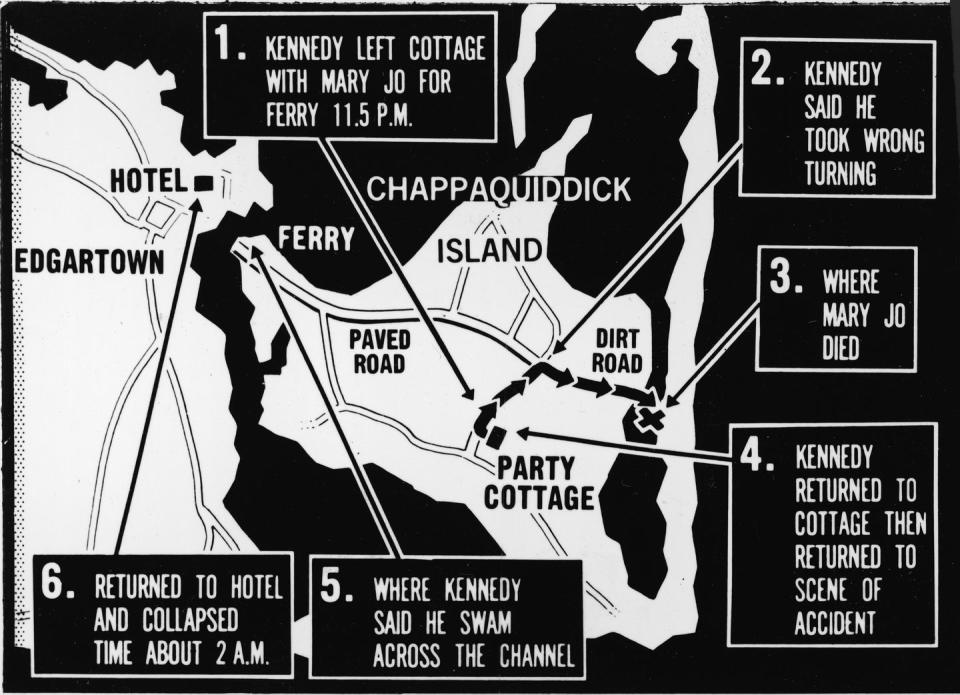What Happened During the Chappaquick Incident

On the night of Friday, July 18, 1969, 37-year-old U.S. Senator Edward "Ted" Kennedy of Massachusetts drove his Oldsmobile off a wooden bridge into a pond on the small island of Chappaquiddick, near Martha's Vineyard. Kennedy survived the crash, but his passenger did not, and the tragedy rocked not just the Kennedy family but the nation.
The event is now the subject of Chappaquiddick, a feature film starring Jason Clarke, Kate Mara, and Ed Helms that debuts April 6. Here's the trailer:
So what really happened that night?
Kennedy, who had been elected majority whip in the Senate the previous January and was a contender for the 1972 Democratic presidential nomination, began the night at a cottage on Chappaquiddick Island hosting a party for the Boiler Room Girls, a group of six women who had worked on his brother Robert F. Kennedy's presidential campaign the previous year. (Bobby Kennedy had been assassinated on June 5, 1968, shortly after winning the California Democratic primary.)

Ted, who was married to his first wife, Joan Kennedy, at the time, left the party just after 11 p.m. with one of the women, a 28-year-old named Mary Jo Kopechne. The two got into Kennedy's 1967 Oldsmobile Delmont 88 and drove off.

According to testimony Kennedy would later give, he made a wrong turn onto Dike Road, an unlit dirt road the led to Dike Bridge, which did not have a guardrail.
His car missed the ramp and went off the bridge into Poucha Pond. Kennedy escaped the overturned car and, according to his description, dove down seven or eight times to attempt to rescue Kopechne. After he was unsuccessful, he walked back to the cottage and recruited his cousin Joseph Gargan and his school classmate Paul F. Markham, who had previously served as the U.S. Attorney for Massachusetts, to return to the accident scene with him.

After unsuccessfully attempting to recover Kopechne's body, the three went to the island's ferry slip, where Kennedy swam across to Edgartown on Martha's Vineyard and returned to his room at the Shiretown Inn.
After changing his clothes, he walked outside at 2:25 a.m. and saw innkeeper Russell Peachey, whom he told he'd been awakened by some noise. (Some speculated it was part of an attempt to establish an alibi.)
At 9:45 a.m. the next morning, after Kopechne's body had already been discovered, Kennedy finally reported the incident to Edgartown Police Chief Dominick Arena and admitted that he was the driver of the vehicle.

On July 25, Kennedy pleaded guilty to leaving the scene of an accident, was given a two-month suspended sentence, and had his license suspended for a year. That night, he gave a statement that was televised and broadcast nationally in which he said, "I regard as indefensible the fact that I did not report the accident to the police immediately."
He denied that he had been driving under the influence of alcohol and said there had not been any immoral conduct between him and Kopechne. He asked his Massachusetts constituents whether he should resign, and on July 30 Kennedy announced he would remain in the Senate and run for reelection.

There has been speculation over the years that Kennedy and his family used their influence to ensure the Senator did not face more severe penalties. In 1979, Ted made his only bid for the presidency, challenging President Jimmy Carter for the Democratic nomination. He loss was blamed, in part, on the scandal that haunted him.
All in all, Kennedy was elected to eight terms as a U.S. Senator, and served from 1962 until his death in 2009. Only three other senators have served longer.
You Might Also Like